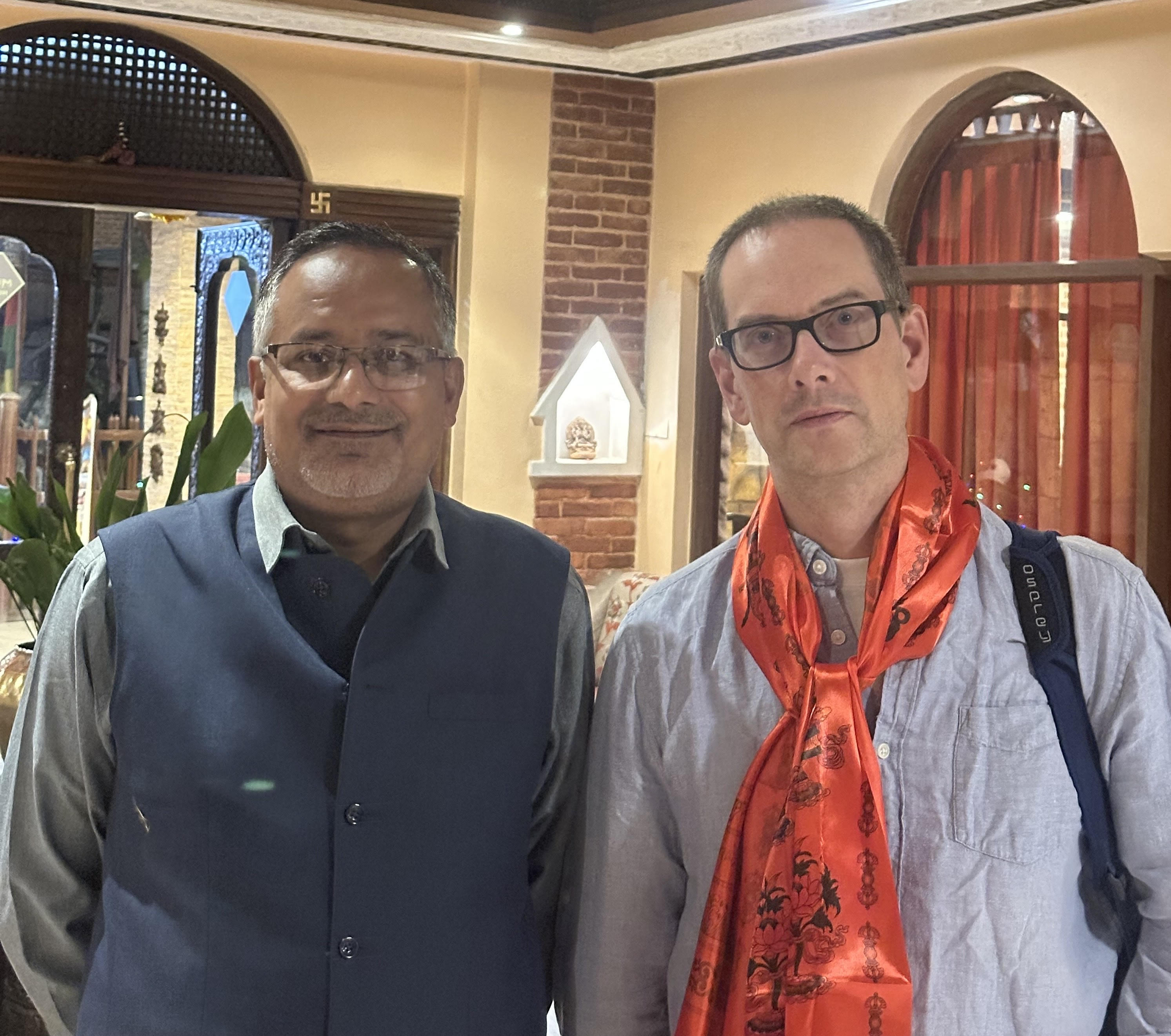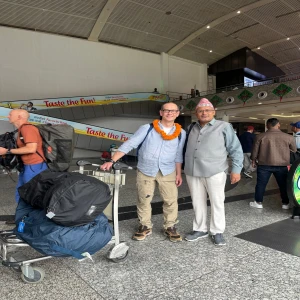Mera Peak is the highest trekking peak in Nepal. It does not require technical climbing but is physically demanding-perfect for anyone with the required fitness and trekking experience in the Himalayas and wanting to try mountaineering.
Mera Peak climbing is one of the best peaks in the Khumbu region to climb. It's an ideal choice for both novice and seasoned climbers, offering a perfect introduction to peak climbing in Nepal. On Mera Peak, you'll not only test your endurance and push your limits but also immerse yourself in the true alpine environment.
Located in the Makalu Barun National Park, Mera Peak is a gem off of the famous EBC trail. The trek to the base camp of Mera Peak is a unique experience, allowing you to explore the beautiful and unspoiled Hinku Valley. The trail, though offbeat, isolated, steep, and rocky, provides the necessary acclimatization and confidence before you climb the peak.
Join us on our Mera Peak climbing 21 days expedition and kick-start your climbing adventure in the Himalayas with a reliable team of mountaineers. We will help you reach the top of the peak and return safely. Bookings are open for Mera Peak climbing 2025/2026 departures. Get your seat now at the best price!
Cost USD 3,486 (March-May). Per Person.
Cost USD 3,311 (June - February) Per person.
(Require minimum 02 peson).
Highlights
- Climb a 6000m peak in the Himalayan range of Nepal
- Conquer the highest trekking peak in Nepal- Mera Peak
- A fantastic 6000m mountain in the Himalayas to climb for beginner climbers
- Learn basic climbing skills and mountaineering vocabulary
- Climb with professional mountaineers who have successfully led numerous climbers to the top of Mera Peak
- Enjoy stunning mountain views and landscapes
- Trek through rhododendron forests, lush meadows, and beautiful villages
- Experience a simple mountain lifestyle and get to know the locals closely
- Take a thrilling Lukla flight to start/end the journey
What to expect during the Mera Peak climbing in Nepal?
Mera Peak has three summits- Mera Central (6,461 m), Mera North (6,476 m), and Mera South (6,065 m). You will be climbing the Mera North, which is the highest one. The Mera Peak route to the north summit follows the Mera La Pass and Mera Glacier.
The journey starts with a short flight to Lukla. From here, you will trek for 9 days to reach Khare. Spend two acclimatization days before ascending from Khare to the Mera Peak Base Camp (Mera La) to the Mera High Camp.
Our Mera Peak climbing itinerary includes rest days in Thagnak and Khare. As we mentioned earlier, the trekking route is offbeat. You will spend nights in Pangom, Nashing Dingma, Chalem Kharka, Chunbu Kharka, Kothe, Thagnak, and Khare villages.
These villages do not offer services like the EBC trail. You will get to witness a different side of the Khumbu region, a less commercialized part. The trails are not crowded at all. If you love peace and nature, you will love the Mera Peak route.
Ascending through dense rhododendron forests, you will go deep into the Hinku Valley. The region is home to wildlife like snow leopards, Himalayan black bears, red panda, and various species of birds and butterflies.
As you ascend through dense rhododendron forests, you'll delve deep into the Hinku Valley, home to a variety of wildlife. While these creatures may not appear on the human trails, a stroke of luck might lead to a sighting.
Additionally, as the elevation rises daily from Lukla, you'll traverse different climatic zones, witnessing a drastic change in the landscape from lush green vegetation to barren hills and glaciers.
You will see mountain views of Everest (8,849 m), Kanchenjunga (8,586 m), Lhotse (8,516 m), Makalu (8,463 m), Cho Oyu (8,188 m), Nuptse(7,861 m), Ama Dablam (6,812 m), Kangtega (6,782 m), and many others throughout the expedition.
Simillary, you will meet mountain communities, including Sherpas, and see their daily lifestyle. The trail is dotted with stupas, chortens, and monasteries. Lungsumgba Gompa is one of the major religious spots in this part of the Khumbu region.
Mera Peak climbing 2026/2027 strategy
Our Mera Peak climbing is 21 days long. You will get one full day in Kathmandu before flying to Lukla to prepare for the expedition. Once you hit the trail, our guide, porter, and supporting crew will be there with you all the time, ensuring your safety and providing the necessary support for a successful climb.
Spend two acclimatization days before hiking to Mera La (the base camp) and the Mera High Camp at 5,780 meters (18,958 ft). During the rest days, you may do some climbing rotations. The team leader will arrange a pre-climbing training as well.
To reach the high camp, you will cross the Mera La Pass at 5,200 m (17,060 ft) and also spend a night here. The high camp is situated behind a large vertical rock. It is a rock shelf, the perfect place to spend a night before pushing towards the Mera summit.
The summit day starts around between 12:00 AM to 1:00 AM. You will start climbing at dawn to reach the summit on time before the late morning winds make climbing impossible. Follow the northern snow slope and climb using fixed ropes set by your crew to the summit of Mera Peak.
Enjoy the view from the top and follow the same route to Mera High Camp. Collect your things and descend to Khare to spend the night. The rest of the team will wait at Khare for you with a celebratory drink. From Khare, you will descend three days to reach Lukla and fly back to Kathmandu.
Who can do the Mera Peak climbing?
Mera Peak is a perfect 6000m mountain for someone who has never climbed before. This peak teaches you the basics of climbing. If you want to experience mountaineering with a high success rate, then Mera Peak climbing is best for you.
Likewise, mountaineers who are planning to climb a 7000m or 8000m mountain and looking to warm up before climbing an advanced mountain can also climb Mera Peak.
Our professional mountaineers will provide you with all the basic knowledge about climbing and teach you important skills. There is no age limit for climbing Mera Peak. However, we require participants to be physically and mentally strong.
Do not underestimate the physical demands of this expedition.
Pre-climbing training
Your team leader leads the pre-climbing training at Khare. He will teach you basic climbing skills and some helpful mountaineering vocabulary. You will learn to climb using fixed ropes, ice axes, crampons, etc.
Likewise, the team leader will also brief you on the climbing plan and inform you what things you should do during an emergency situation. This session will help you become confident and increase your success rate.
How do you prepare for Mera Peak climbing?
To prepare for Mera Peak climbing, you must train your body and mind. You have to get physically active and push yourself. Build your strength and stamina. You can go on high-altitude trekking and day hiking. If you have access to special gyms that are made for athletes to increase their endurance, you can join that as well. Remember, the more prepared you are, the more you'll enjoy and succeed in this adventure.
Why climb Mera Peak with us, Adventure Treks Nepal?
We, Adventure Treks Nepal, are known for our thirty years of experience and very skilled on-field team. By joining the Mera Peak climbing with us, you will climb this mountain with the strongest individuals who have conquered it numerous times before. You will be in reliable hands, and we will do everything to keep you safe while climbing.
Likewise, we provide our climbers with the latest climbing gear and equipment. Our gear is well-managed and thoroughly checked before every expedition. You will be equipped with the best. Our support team will take care of all the logistics and high-camp service. Not to mention, our Mera Peak climbing cost is also the most reasonable.
Note that we do not compete to provide the cheapest price in the market. Rather, we believe in providing the finest service, high satisfaction, and safety assurance. If you have any queries about the Mera Peak climbing package, contact us anytime.








.jpeg)





